Understanding Content Modeling & Structuring in Headless CMS

What’s Inside
- What Is a Content Model?
- Why Is Content Modeling Important?
- How Headless CMS Enables Content Modeling?
- Content Modeling Example
- Explore Experro's Unmatched Content Modeling Capabilities
- What Are the Benefits of Experro Content Modeling?
- Value of Content Modeling in eCommerce
- 4 Factors to Consider Before Implementing Content Modeling
- Conclusion
Key Takeaways
- Content modeling and structuring play pivotal roles in enhancing the efficiency of websites, benefiting both companies and users.
- Businesses can optimize their strategies by effectively performing content modeling, including SEO (Search engine optimization).
- Adapting a headless CMS provides an ideal foundation for enabling content modeling and enhancing online presence.
According to Semrush Blog, 44% of the respondents stated that improving the quality and value of the content is a crucial factor for an organization's success. Therefore, it is evident for brands to deliver valuable content.
However, simply posting content is insufficient, as its efficiency relies on proper structure and organization.
Content modeling benefits both the audience and the team by ensuring a unified experience and efficiency.
While crafting and publishing content may not be difficult, maintaining its structure, efficiency, and enhancing user experience becomes challenging in today’s fast-paced digital environment.
Sounds confusing? Let us explain why!
Audience demands are rapidly increasing, and they want tailored experiences on the tip of their fingers.
On the other hand, developers find it challenging to keep up with the latest trends and deploy content quickly. Especially when they are dealing with a larger audience and extensive content database, these tasks become daunting.
So, what's the solution?
A full fledge headless CMS helps you in taking a transformative approach to manage content.
Stay tuned to discover how the headless model of CMS enables content modelling and structuring, ultimately strengthening your content game.
What Is a Content Model?
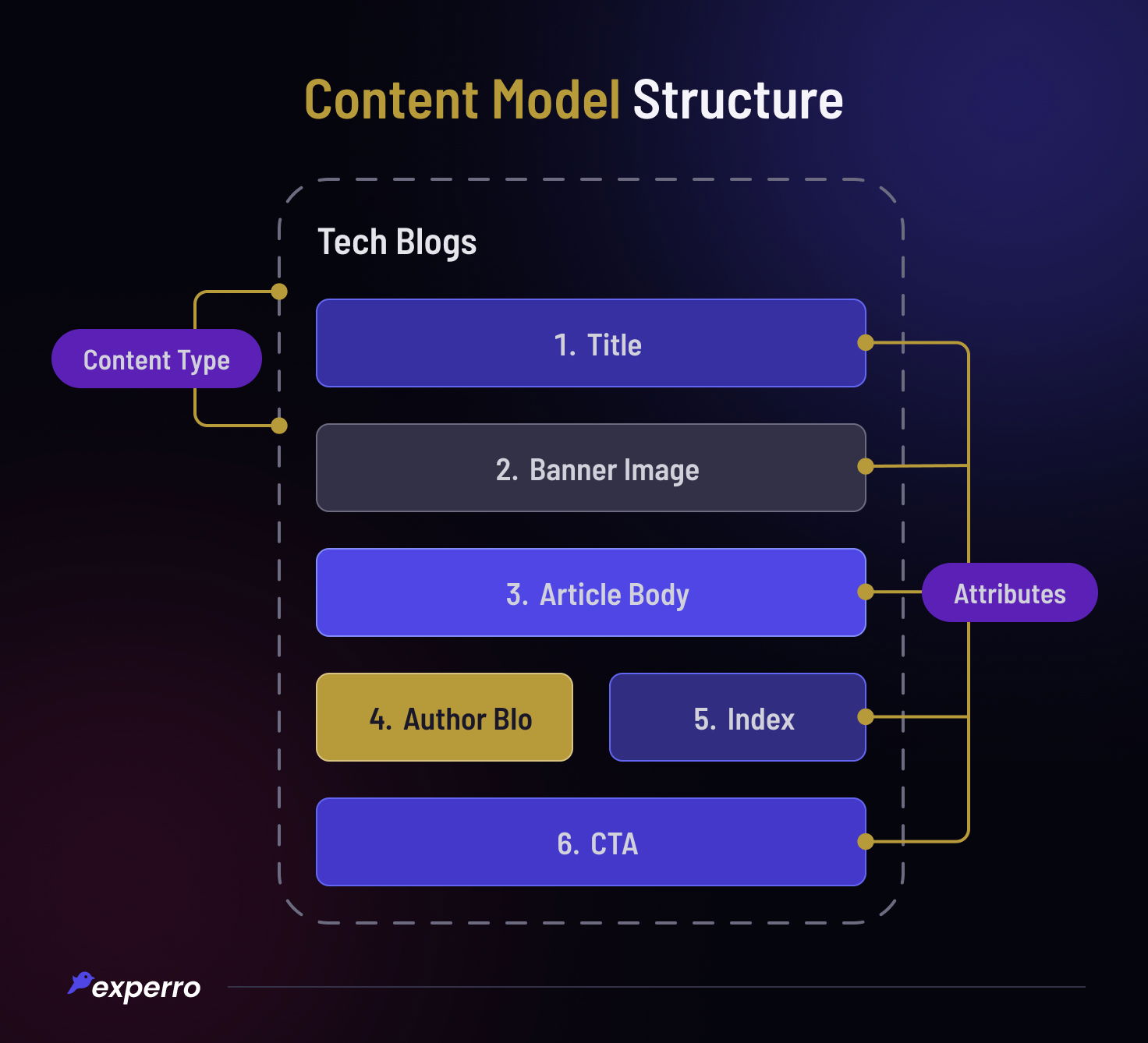
Effective content presentation is crucial for a website with a large amount of content. Without classification and structure, a cluttered and unclassified website can lead to poor user experience. This is where the content modeling comes into play.
Content modeling documents the content structure within the organization, providing a clear understanding of content classification and elements. It identifies the relationship between different types of content and their attributes.
Creating the most basic content models starts with content mapping. It involves defining content types and attributes and breaking them down into small units.
Adding more to this, a content map helps to identify relationships between different elements of content. Content relationship and classification ensure consistency across all content data of website.
Content modelling doesn’t only benefit the website but content strategists, designers, content writers, developers, and users, ensuring better content quality. It streamlines the process between employees and encompasses better user experience across multiple channels. Furthermore, it boosts the content strategy of your business.
Ultimately, the core of every website is rooted in delivering better content. It increases the overall efficiency of the website and yields numerous benefits, which we will explore further in this blog.
Why Is Content Modeling Important?
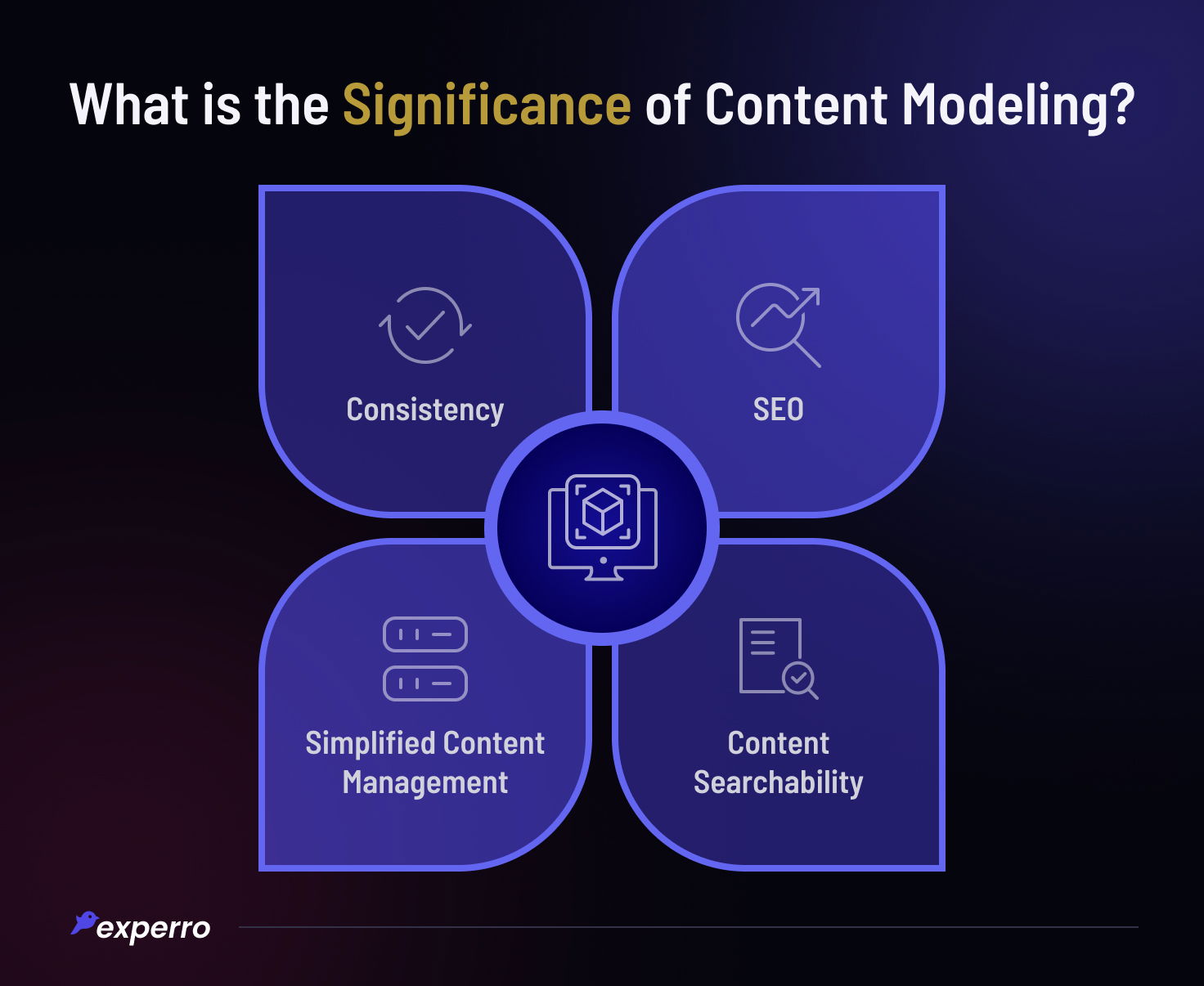
Now that we know what is content modeling, let’s understand how important it is for the effectiveness of an organization from the points mentioned below:
1. Provides Consistency Across Multiple Digital Channels
Did you know? An average American spends 7 hours using the phone screen. the substantial amount of time indicates people are constantly consuming content on their phone screens.
Nowadays, content is not just limited to a single point of interaction instead multiple channels, such as websites, social media, mobile apps, etc. Therefore, it is important for the brands to maintain consistency over all channels.
Content modelling ensures consistency of all the content of the website throughout. For example, a website’s blog section may have content classified into blog categories, title, author name and bio, publication date, and body text.
The consistent content structure ensures creators, developers, and designers are aligned with activities and users can easily navigate the blogs with a consistent and structured format.
2. Enables SEO Content Strategy
Why create and publish abundant content when there is no one to engage with? The goal of your content is reaching the desired audience and ranking for SEO.
Content models present a comprehensive approach for structured content lifecycle management. A well-designed content model of web page helps search engines to classify the content, increasing the website’s overall value.
It also enables the search engine to crawl relevant data and navigate the website's content ecosystem.
3. Simplifies Management of Content Model Documents
Appropriate content model enables smooth workflow among content creators, developers, and designers. With the proper content model and structure, they can edit the content without any hassle.
Since it streamlines the workflow and eliminates the need for frequent errors, it eventually increases the team's productivity.
For example, an eCommerce website may have a product model that includes product name, description, price, features, and availability. A clear content model will improve efficiency as employees know when to remove, edit or add any product information.
4. Enhances Content Searchability
A well-designed content model eliminates the time users spend searching for information. The content model enhances the categorization of different types of content. It defines the relationship between content types, which makes it easy for users to navigate and find relevant content.
For example, an eCommerce website has various product categories and attributes, allowing users to navigate the product they want to search for.
Now that we know how important content modeling is for the effectiveness of your content strategies and user experience let’s have a look at how headless CMS enables it.
How Headless CMS Enables Content Modeling?
The headless model of CMS is a widely popular system used across various digital platforms. A total of 82.91% of companies reported that switching to a headless CMS improved time, budget, productivity, meeting their KPIs, and revenue.
From content modeling to enabling content-first marketing strategy, headless CMS provides numerous benefits to organizations.
The separated architecture enables agile content delivery and greater flexibility. But the key here is to choose the best headless CMS among plethora of options available.
The Problem with the Traditional CMS Approach
Traditional CMS has been a choice of many organizations before. However, times have changed with changing customer demand and the unprecedented rise of the digital industry. Now, customers want a seamless experience over all digital channels.
Unlike the headless model of CMS, traditional CMS has a tightly coupled architecture. It prevents the developers from making changes in content. Here traditional CMS architecture falls short in overcoming content challenges due to its lack of flexibility.
Let’s understand how headless CMS structure enables content modeling with bullet point list mentioned below:
- The separated architecture of headless CMS allows creating custom entities and fields for different content categories.
- The API-driven content delivery allows delivering content on multiple channels consistently.
- With headless model of CMS, content can be repurposed for various digital channels allowing consistent content models.
- Headless CMS enables relationship establishments between various types of content, which makes it easier for users to navigate.
Content Modeling Example
Let's understand content modeling from the example of poorly designed content model vs well-structured content model of blog post.
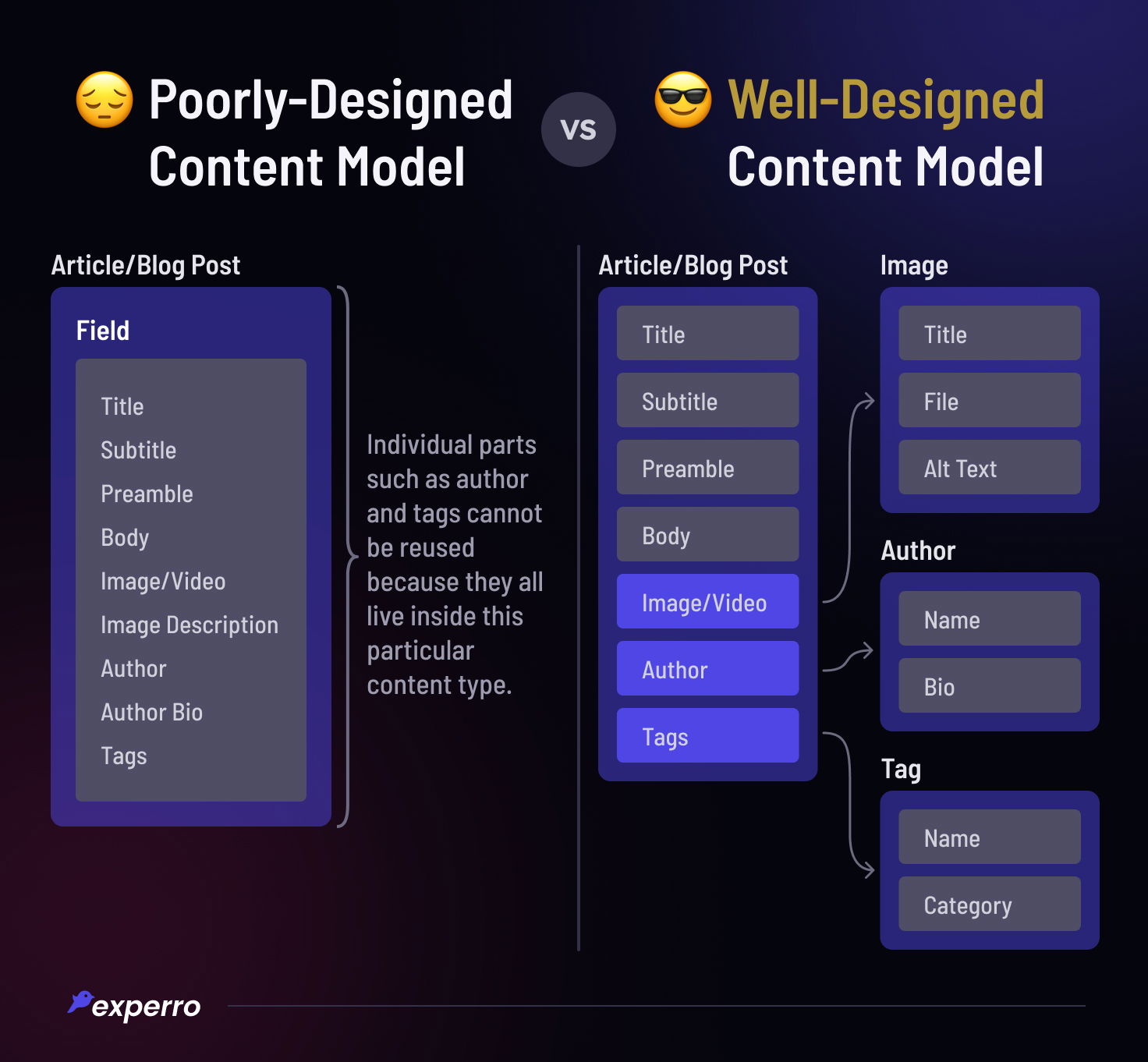
Poorly designed content model doesn't have an established relationship between content and content attributes. It has yet to define content elements, which makes it challenging to establish context and provide a better user experience.
Modeling content also makes it difficult to make changes in the future due to a lack of proper structure. This may eventually hinder the growth of the website and user engagement.
Whereas a well-designed content model of a blog post successfully establishes the relationship between various content elements and ensures a cohesive flow of information. Furthermore, a well-designed content model enhances user experience by enabling quick navigation.
Explore Experro's Unmatched Content Modeling Capabilities
Go through the points mentioned below to discover how a leading platform Experro enables content modeling.
1. Reviewing Content
To create a content model, first start by reviewing your website's content.
Even if you are in the early stage of building a website, you can start by taking inspiration from a competitor's website. analyze their content format and finalize the suitable one for you. Create a rough content design for each type and composition.
2. Identify The Structure
Taxonomies and categorization involve identifying the hierarchy of the content based on specific criteria. It allows the organization and the developers to understand the content flow easily. For example, educational websites have different hierarchical categories for students in different grades.
3. Defining Content Types and Attributes
Defining content types includes documenting different types of content for better understanding for users. This could involve Title, Banner image, date and time, author and article body. By systematically outlining these elements users can navigate the structure and purpose of content types, enhancing the overall user experience.
4. Relationship Between Content Types
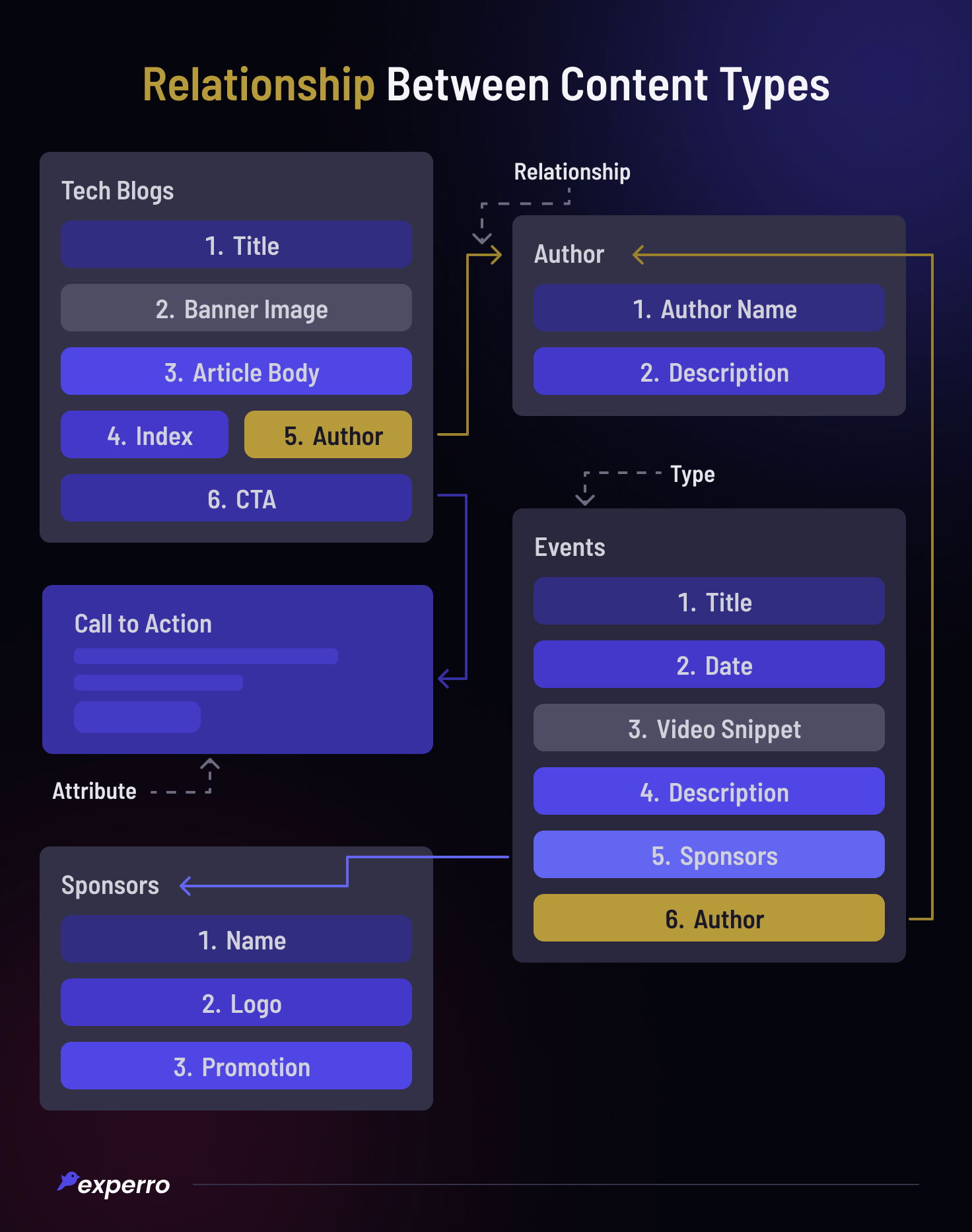
Establishing relationships between different content elements enables organizations to understand each content type and its associations with other factors. This facilitates future content editing and ensures a seamless flow of information.
In addition, by establishing these relationships, organizations gain insights into how each content piece fits into the larger context, allowing for better management and organization of content assets.
What Are the Benefits of Experro Content Modeling?
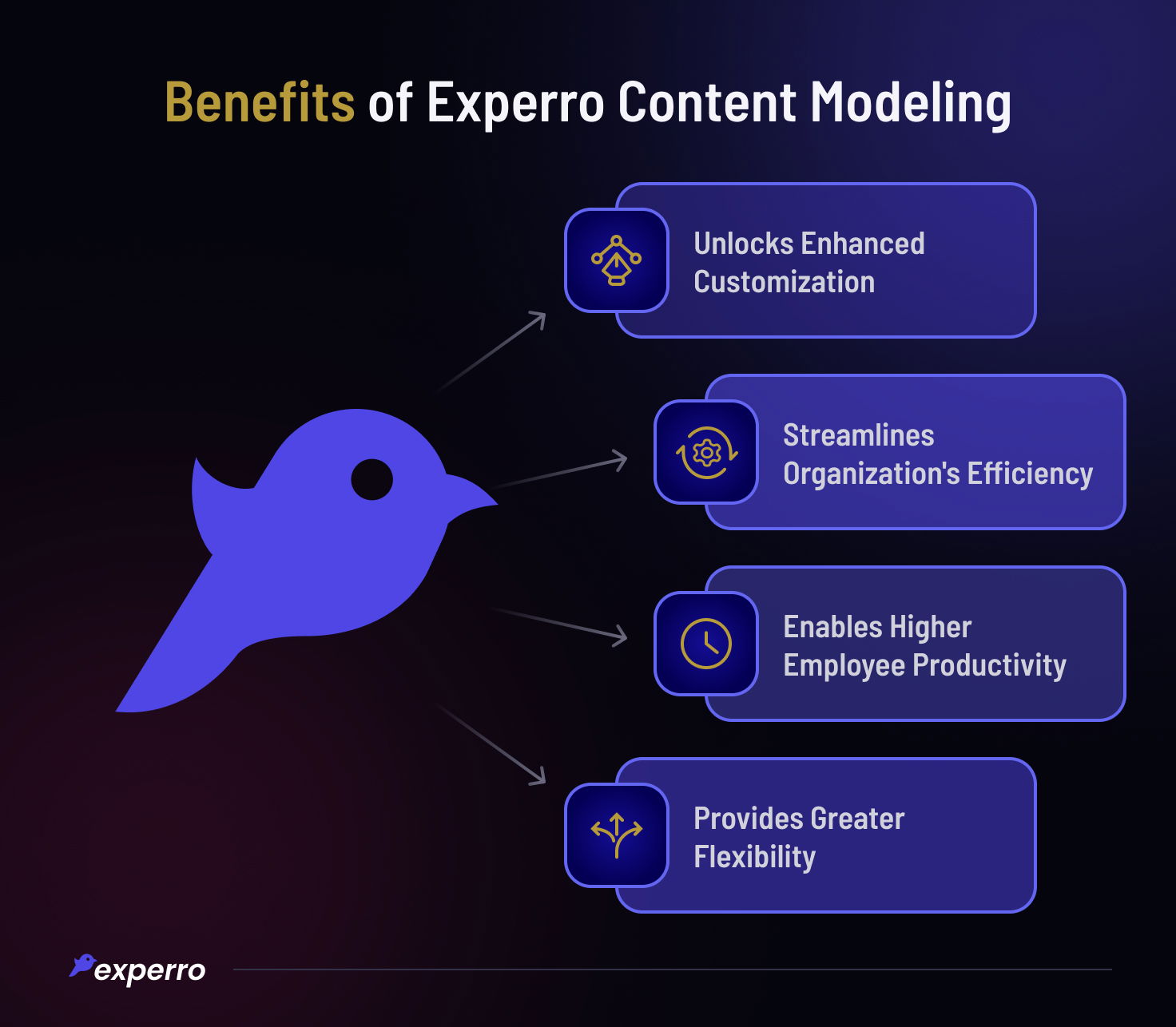
Stay ahead in today's ever-evolving digital landscape by experiencing Experro's headless CMS. Go through the points mentioned below that highlight the benefits that Experro uncovers for your organization.
1. Unlocks Enhanced Customization
Experro creates a customized content model based on the user needs. Whether you have just started to scale your content journey or have a huge catalog, Experro has got you covered.
Customization allows the extensive creation of content types, attributes, and elements according to your requirements. For example, an eCommerce website can create a content model based on its products, features, price, descriptions, availability, etc.
2. Streamlines Organization's Efficiency
Content model in Experro enables the efficiency of your organization by streamlining content creation, management, and updates. It ensures consistency across the organization and eliminates the possibility of errors.
For example:
A marketing team can create a content model to ensure standardization across teams, such as posting blogs and designing and editing content.
3. Enables Higher Employee Productivity
The API-driven content delivery delivers content seamlessly on multiple digital channels. With consistent and structured content on all channels it reduces the time to recreate content for various channels and allows the team to focus on more important tasks. Eventually, enhances the productivity and efficiency of the organization.
4. Provides Greater Flexibility
The flexible architecture allows developers to modify content models according to the organization’s changing needs. Moreover, it enables easy content reuse on multiple digital channels.
Flexibility to modify content modules makes it easy to keep up with the latest trends and information. You can create multiple pieces of content from the existing content unit. This is how you can serve multiple purposes on various digital touchpoints.
Value of Content Modeling in eCommerce
The eCommerce content model brings significant value from the business and the customer’s perspective. Leading to tangible growth opportunities and better user experience.
Here are the points that illustrate the value of modeling content in eCommerce business.
1. Consistent Brand Experience
It is important to maintain consistency and create a unified experience for establishing a strong brand voice. Consistency over various brand touchpoints, such as websites, mobile apps, and social media, fosters trust and credibility among customers.
2. Improved Conversion
Better content modeling improves product discovery, user engagement, and user experience. By providing a great content model, you can increase the searchability of the item, which makes users visit the website repeatedly due to a unified experience. Furthermore, a better user experience eventually increases website visits and conversions.
3. Enhanced Personalization
Content modeling with headless CMS enables capturing of data of customers, providing the necessary information to create a personalized experience. And personalization is the key to eCommerce business being customer centric.
4. Excellent Scalability
Content modeling in a headless CMS facilitates scalability and rapid content updates, supporting business growth and agility. With a structured content model, businesses can efficiently manage large product catalogs, add new categories, and update content across multiple channels, saving time and effort.
4 Factors to Consider Before Implementing Content Modeling
Now that you are all set to create a content model, consider these factors mentioned below for greater efficiency.
1. Understanding The Needs of the Target Audience
Analyzing content requirements and understanding the needs of your target audience is important to create a robust content model.
It includes analyzing factors such as what your target audience searches for and what they need, their taste and preference. It will give you a detailed perspective on creating a customized content model for them, enhancing the user experience.
2. Understanding User Journey
Before making a final decision to purchase, customers go through a defined user journey, such as researching the product info, comparing it, evaluating prices, etc.
Therefore, it is necessary to identify your user’s journey and then make an informed content model based on that. Each stage of the content model should align with the user’s journey so that they find all the information related and tailored just for them.
3. Collaborative Approach
Adapting collaborating approach involves including stakeholders, designers, content teams, and developers’ opinions. It will enhance teamwork and content workflow efficiency. Furthermore, it fosters stakeholders’ trust and helps them make an informed decision.
4. Reviewing Content Models
Testing and reviewing will ensure the effectiveness of your content model. It is crucial to monitor and analyze the new model’s performance. You can also identify if there are any areas of improvement in the model and work on the same before implementing.
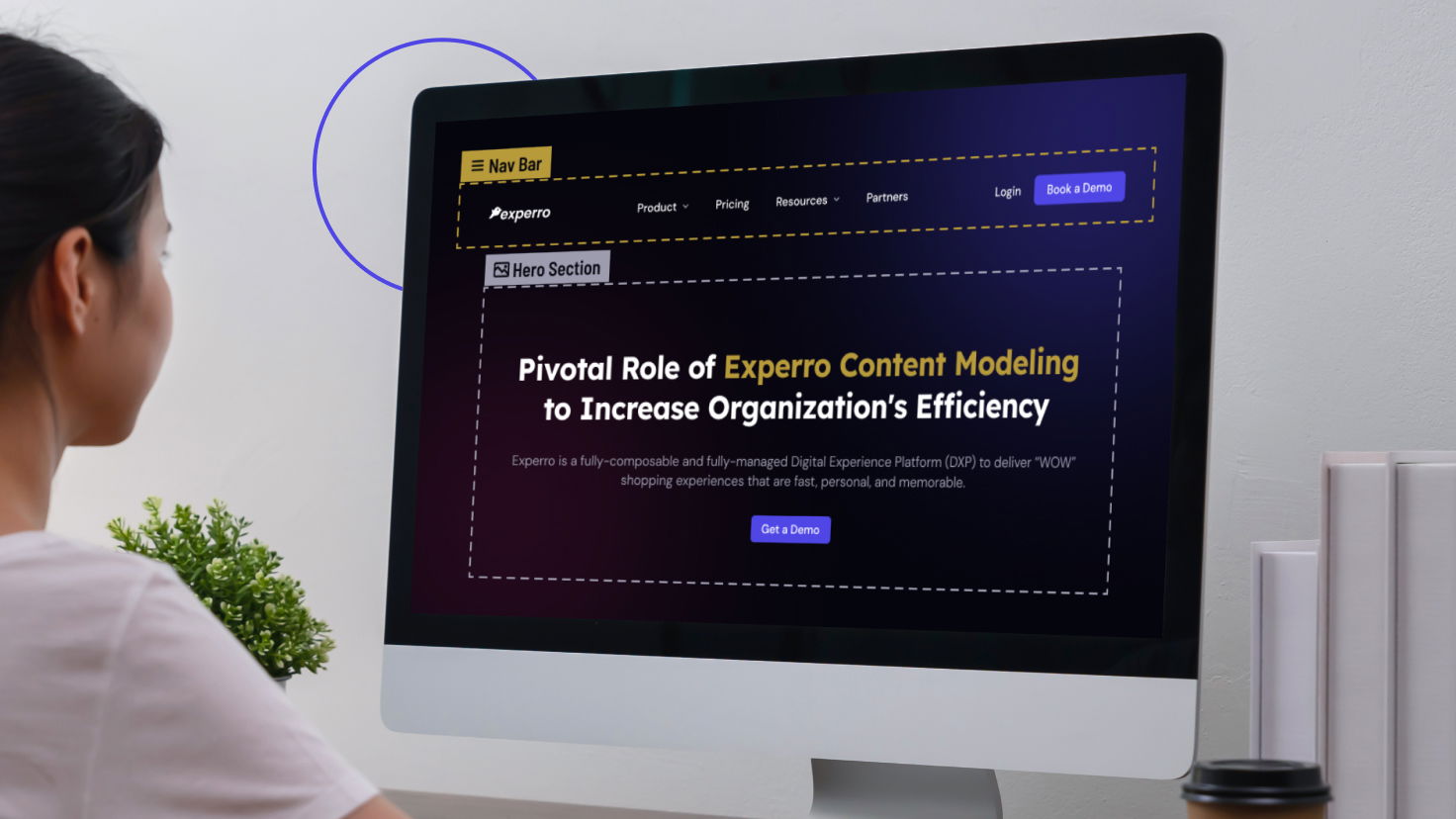
Conclusion
In conclusion, content modeling plays an important role in leveraging the full potential of a headless CMS. By defining the content structure, attributes, and relationships, businesses can achieve consistency, personalization, and efficiency in their content management processes.
Choose the most appropriate headless CMS to unlock these benefits. It will lead to improved user experiences, streamlined workflows, and scalability, all essential for business growth in today's digital landscape.
Stay tuned for more!
FAQs


Priya Zala
25 June 2024Through her writing, she has a lovely way of capturing users' pain points and delivering solution-oriented content. Her writing is sure to captivate readers and leave them with a lasting impression. When not crafting content, Priya enjoys getting lost in a good work of fiction, which soothes her soul.